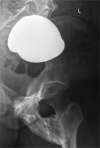Fibrodysplasia ossificans progressiva (FOP): watch the great toes!
- PMID: 20577760
- PMCID: PMC4964587
- DOI: 10.1007/s00431-010-1232-5
Fibrodysplasia ossificans progressiva (FOP): watch the great toes!
Abstract
Fibrodysplasia ossificans progressiva (FOP) is a rare genetic disorder and the most disabling condition of heterotopic (extraskeletal) ossification in humans. Extraskeletal bone formation associated with inflammation preceding the osseous conversion usually begins in the first decade, predominantly in the head, neck, and shoulders. All patients have malformed great toes. Most patients have a spontaneous mutation of the ACVR1 gene. We report a 17-year-old girl with malformed great toes who had her first episode of heterotopic ossification and impaired mobility of the left hip at the age of 13 years. No inflammatory fibroproliferative masses preceded the onset of heterotopic ossification. Radiographic studies demonstrated myositis ossificans, but failure to associate the great toe malformation with heterotopic ossification led to a failure to diagnose FOP. She underwent repeated and unnecessary operative procedures to remove a recurrent lesion. FOP was finally suspected when the great toe malformation was correlated with the trauma-induced heterotopic ossification. Genetic analysis confirmed the presence of the classic FOP mutation (ACVR1 c.617G>A; R206H). This case highlights the importance of examining the great toes in anyone with heterotopic ossification. The association of malformations of the great toe with heterotopic ossification in all cases of classic FOP will lead to prompt clinical diagnosis and the prevention of iatrogenic harm.
Figures




Comment in
-
Are great toes always abnormal in patients with fibrodysplasia ossificans progressiva?Eur J Pediatr. 2011 Apr;170(4):541; author reply 543. doi: 10.1007/s00431-011-1406-9. Epub 2011 Feb 2. Eur J Pediatr. 2011. PMID: 21287356 No abstract available.
References
-
- The medical management of FOP: current treatment considerations. 2010 Anonymous www ifopa org.
-
- Cohen RB, Hahn GV, Tabas JA, et al. The natural history of heterotopic ossification in patients who have fibrodysplasia ossificans progressiva. A study of forty-four patients. J Bone Joint Surg Am. 1993;75:215–219. - PubMed
-
- Connor JM, Evans DA. Fibrodysplasia ossificans progressiva. The clinical features and natural history of 34 patients. J Bone Joint Surg Br. 1982;64:76–83. - PubMed
-
- Glaser DL, Kaplan FS. Treatment Considerations for the Management of Fibrodysplasia Ossificans Progressiva. Clin Rev Bone Mineral Metabol. 2005;3:243–250.
Publication types
MeSH terms
Substances
Grants and funding
LinkOut - more resources
Full Text Sources

